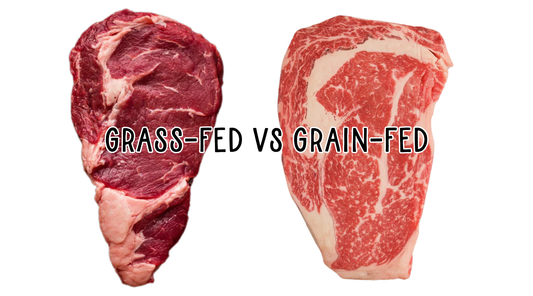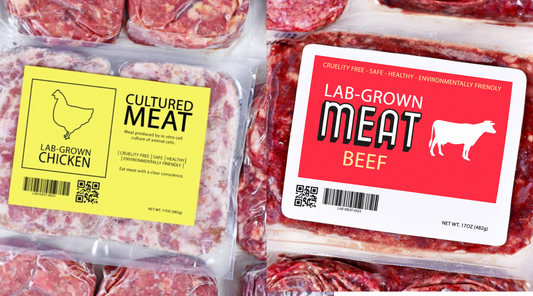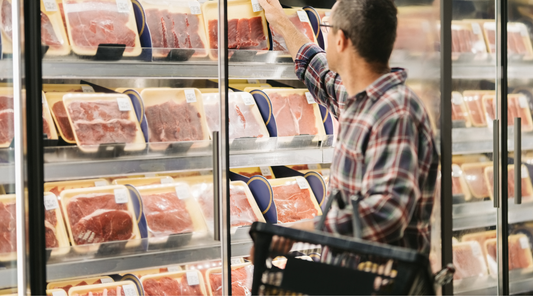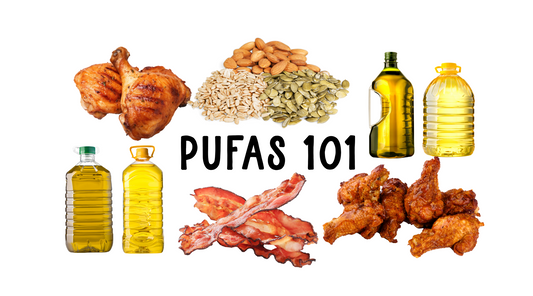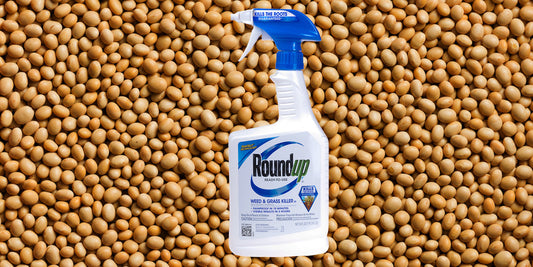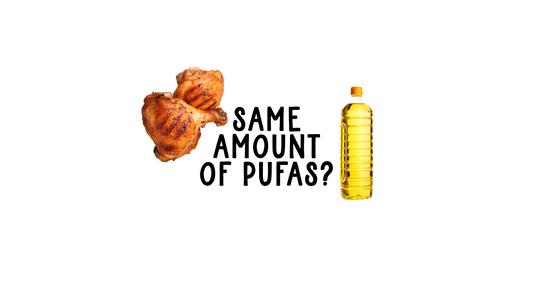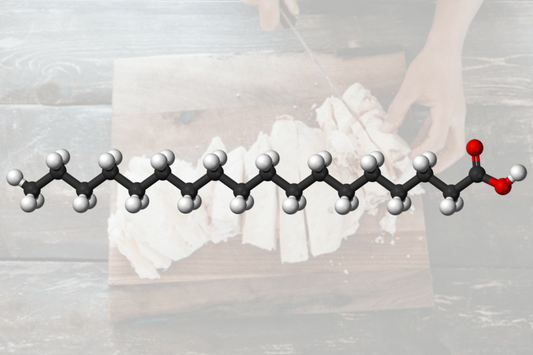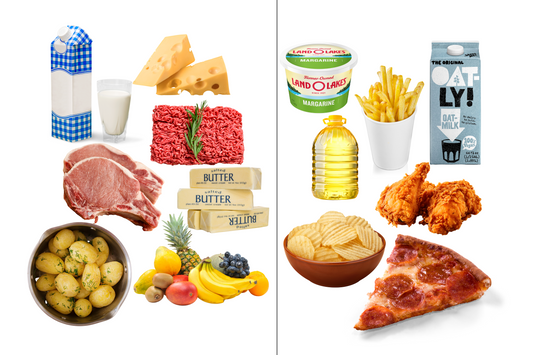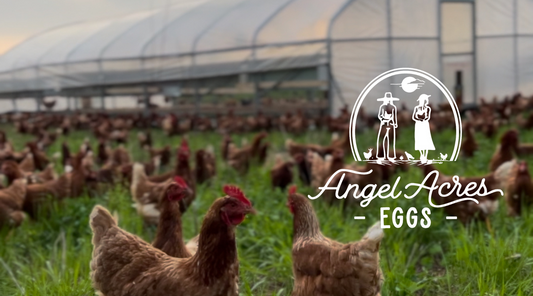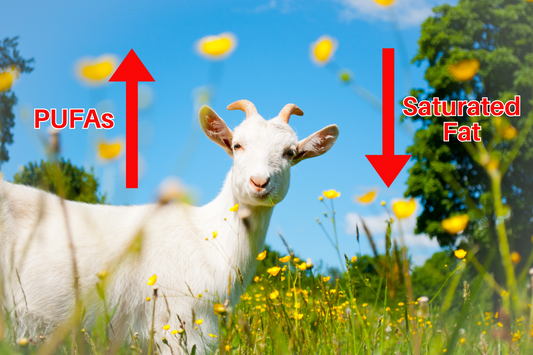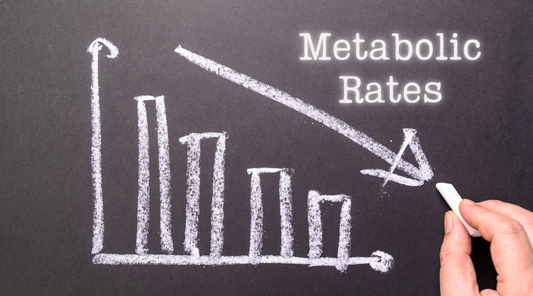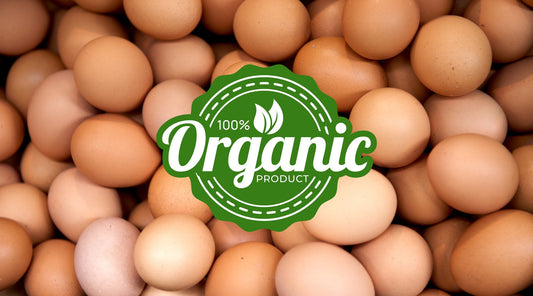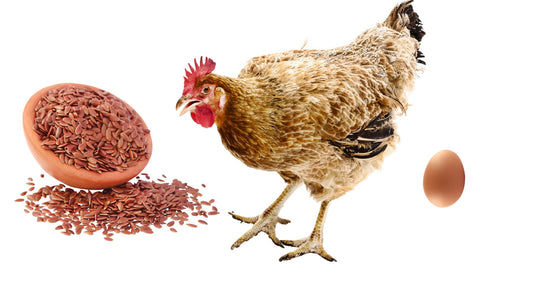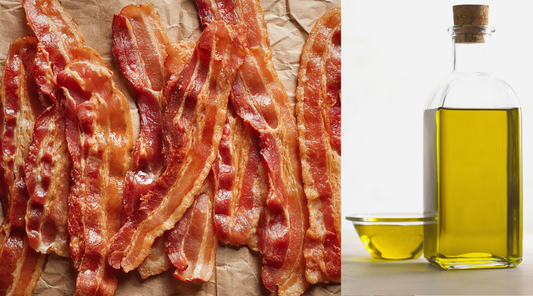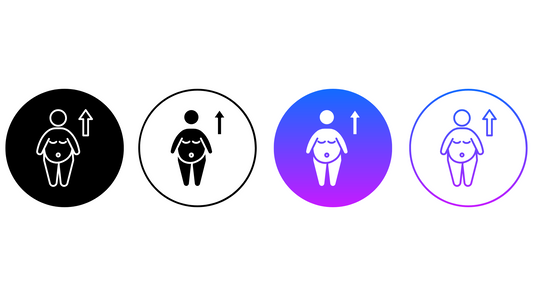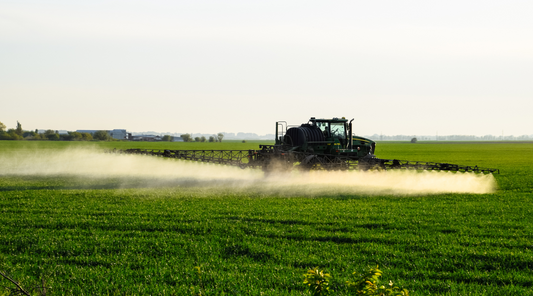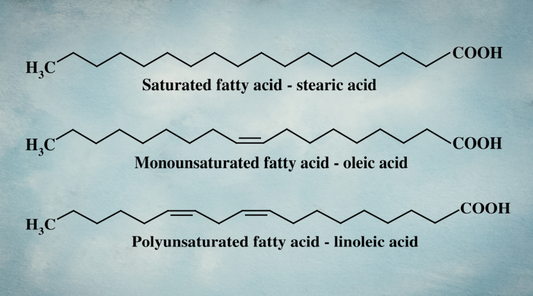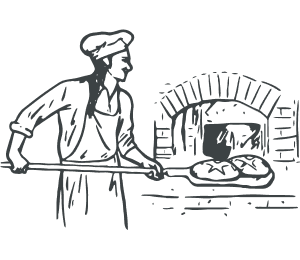
The Truth About Pesticides: Endocrine Disruption, Regulatory Failure, and Food System Fallout
In addition to the rise of PUFAs and phytoestrogens in our food supply, another major shift is our growing exposure to pesticides - and it’s not just on produce.
Pesticides contaminate the entire food chain. In conventional crop production, they’re sprayed heavily on grains, fruits, and vegetables. But they also show up in meat, milk, and eggs.
Animals raised in confined, industrial systems are fed pesticide-laden grains and live in environments where toxic chemicals are routinely used to fight nature. These residues don’t just disappear - they accumulate in the animal’s fat, organs, and secretions, eventually ending up in the food we eat.
Chronic pesticide exposure is linked to endocrine disruption, fertility issues, gut disturbances, metabolic problems, and chronic disease development. It’s a slow, silent burden your biology was never designed to handle.
While humans have used natural pest control methods for thousands of years (think sulfur in ancient Sumeria, diatomaceous earth in ancient Egyptians, and chili pepper sprays used by Mesoamerican farmers) the era of toxic synthetic pesticides didn’t take root until the 1940s. And since then, it’s only accelerated.
Take glyphosate, for example, now a household name. Originally synthesized in 1970 as a metal chelator, it was repurposed by Monsanto into the now-infamous herbicide Roundup, introduced to the market in 1974. Glyphosate use exploded in the 1990s after genetically modified “Roundup Ready” crops were released - engineered to survive being drenched in the herbicide. This allowed farmers to blanket entire fields in glyphosate without harming the crops themselves. The result? Glyphosate use didn’t just increase - it skyrocketed by as much as 300-fold since the 1970s. 1
So, we have to ask - what are the long-term health consequences of this massive chemical experiment? Truth is, we still don’t fully understand and still don’t have answers to. Is this a gamble we’re willing to keep taking?
Even the US government admits there is evidence pesticides are harming human health. Yet, they have completely dropped the ball. 2 The very agencies tasked with protecting public health have dragged their feet, delayed testing, and allowed corporate interests to dictate the pace of regulation. Nearly three decades later, we’re still waiting on the most basic safety evaluations of chemicals that saturate our food, water, and soil.
A Broken Promise: How the Government Failed to Screen Pesticides for Hormonal Harm
Let’s rewind to 1996—a pivotal year when the Food Quality Protection Act (FQPA) was signed into law. 3 This Act was supposed to be a turning point and may have had good intentions. But it has epically failed.
The FQPA gave the EPA a new mandate: protect human health from pesticide exposure, including evaluating whether these chemicals act as endocrine disruptors - compounds that can interfere with hormones and metabolism, even at tiny doses. “The new law required the EPA to develop a screening program specifically to determine if chemicals used in pesticides had estrogenic properties.” 4
Before 1996 and the FQPA, a policy called the Delaney Clause was used to evaluate pesticides. It was a strict, hazard-based approach, where if a pesticide was found to cause cancer in animals or humans at any level, it couldn’t be used in food at all. Even a tiny trace meant a ban.
After 1996, the FQPA replaced the strict, hazard-based approach with a more lenient, risk-based model. Instead of banning a chemical simply because it was hazardous, regulators now considered how much of it people were exposed to - and whether that specific amount was likely to cause harm. Under this new system, a pesticide could still be allowed in food as long as the exposure was deemed “low risk,” even if the chemical itself was clearly hazardous in larger doses.
This shift was a major win for pesticide manufacturers. It gave them far more leeway to keep toxic compounds on the market - so long as they could argue the public was only getting a “safe” dose.
Instead of banning all carcinogens outright, as the Delaney Clause once required, the FQPA opened the door for them to remain in our food supply - as long as the risk was deemed acceptable.
The law also required the EPA to establish a comprehensive Endocrine Disruptor Screening Program (EDSP). To guide the process, a federal advisory committee - comprised of scientists, public health experts, and representatives from the chemical industry - was formed to determine how to prioritize and screen the vast array of chemicals already in circulation.
At the time, more than 80,000 chemicals were in use. So how many did they start with? Just 52, fewer than one-tenth of one percent.
How did they land on such a small number? That part remains frustratingly vague. But the strategy they laid out was a two-tiered testing system:
-
Tier 1: A broad screen to identify whether a chemical could interact with hormonal systems—estrogen, androgen, or thyroid receptors.
-
Tier 2: A deeper dive to evaluate whether those interactions actually caused harmful endocrine-related effects, and at what levels.
Sounds like progress, right?
Wrong.
Despite the urgency of the issue, implementation was an absolute mess. Not only were the deadlines missed - they weren’t even close.
Tier 1 testing didn’t even begin until 2009 - thirteen years after the law was passed. Tier 2 testing? Still not validated to this day. And many of the chemicals flagged in Tier 1 as potentially disruptive have never been followed up on. That’s 29 years of delay with no test orders issued and no clear plans to resume Tier 1 screening, according to the EPA’s own website. 5
This wasn’t just a bureaucratic fumble with a federally mandated program. It was a systemic failure - one that has allowed endocrine-disrupting chemicals to remain in the food supply, largely unchecked, for nearly three decades.
In 2021 - 25 years after the FQPA was signed into law and a full decade after the EPA’s first report - the EPA’s own Inspector General released a second evaluation of the Endocrine Disruptor Screening Program (EDSP). 6 His findings were alarming:
-
The EPA had identified over 1,300 chemicals as high-priority due to their widespread use in pesticides. Yet only a small fraction had even been considered for screening—let alone tested. Hmm, sounds like Big Ag lobbying dollars at play.
-
The EDSP has completely stalled, despite being required by federal law.
-
After the EPA received data from the first 52 Tier 1 tests, they changed how they evaluated the results. In other words, they moved the goalposts after seeing the data. Instead of using a consistent, science-based framework to determine which chemicals posed endocrine risks, the agency altered its evaluation approach—effectively rewriting the rules mid-game. This not only introduced bias, but also calls into question the validity of the entire screening process.
-
Perhaps most alarmingly, some EPA staff admitted that they were told to operate as if the EDSP had been defunded entirely.
-
In fiscal year 2021, the program received a paltry $7.5 million budget and had only four full-time staff members assigned.
It’s now been 29 years since the FQPA passed, and the federal government still hasn’t completed its legal obligation to test pesticides for their endocrine-disrupting potential.
This is a glaring example of how Big Ag uses its massive lobbying power to water down or delay regulation. While they rake in profits, the public bears the burden of chronic exposure to poorly studied and potentially hazardous chemicals.
When the very agency tasked with protecting us rewrites the rules to favor the industry it’s supposed to regulate, it stops being a watchdog and becomes a lapdog.
What Are Pesticides, Anyway?
Let’s break it down.
The term “pest” refers to any organism (insects, weeds, rodents, fungi, bacteria, etc.) that is considered harmful or undesirable, particularly in agricultural settings. And then “-cide” is a suffix derived from the Latin word caedere, meaning “to kill.”
So, “pesticides” is an umbrella term for substances designed to kill pests. Subcategories include herbicides for weeds, insecticides for insects, fungicides for fungi, rodenticides for rodents, nematicides for nematodes, bactericides for bacteria, molluscicides for slugs and snails—the list goes on.
And it makes even more sense when you understand where pesticides really came from -- weapons of war repurposed for the farm.
Pesticides became a mainstay in agriculture after World War II, when the same chemical manufacturing infrastructure built for war was redirected toward food production. Ammonium nitrate, once used in explosives, became synthetic fertilizer. Organophosphates - first developed as nerve agents - were reformulated into insecticides. Yes, nerve agents. These chemicals disrupt the way nerves transmit signals in the body. In war, they paralyze or kill. In agriculture, they “just” kill pests.
But it’s naive to think that chemicals designed to destroy life come without collateral damage when used in food production. There are ALWAYS consequences trying to fight natural biology with chemistry.
Many of these chemicals are often formulated to target “specific” biological processes — for example, glyphosate blocks an enzyme in the shikimate pathway, which plants need but animals don’t have. And insecticides bind to neural receptors in insects.
On paper, it looks clean and precise. In reality, these compounds tend to behave more like grenades than scalpels, often impacting far more than their intended targets.
To provide a little more context, here are 5 of the most commonly used pesticides in the US. Many of these have been shown to disrupt hormones, impair fertility, increase the risk of birth defects, increase oxidative stress, damage mitochondria, impair gut health, hinder cognitive development, and elevate cancer risk.
-
Glyphosate: A broad-spectrum herbicide that is the active ingredient in Roundup, used to control a wide range of weeds and grasses. Used on genetically modified crops like corn, soy, and cotton for weed control, and as a pre-harvest desiccant on non-organic, non-GMO grains like wheat, oats, barley, and legumes. That means it’s sprayed just before harvest to kill the crop and speed up harvesting - leaving high levels of residue behind in your food.
-
Atrazine: A popular herbicide in corn production (used on both GMO and non-GMO varieties). Since non-GMO corn isn’t resistant to glyphosate, conventional growers often turn to atrazine instead. Banned in the EU since 2004 due to groundwater contamination and hormone disruption.
-
Chlorpyrifos: An organophosphate insecticide that targets insects’ nervous systems. Banned in the EU, Canada, UK, Australia, New Zealand, China, Brazil, and South Africa. The U.S. EPA banned it from food crops in 2021 due to its links to neurotoxicity in children. But after legal pressure and industry lobbying, the ban was overturned in 2023. It’s now allowed again on 11 crops, including alfalfa, apple, asparagus, tart cherry, citrus, cotton, peach, soybean, strawberry, sugar beet, and wheat.
-
2,4-D: A selective weed killer used in corn, wheat, rice, hayfields, and even lawns. It’s still widely used today in both GMO and conventional agriculture. The IARC classifies it as “possibly carcinogenic to humans” and some studies have linked it to non-Hodgkin lymphoma.
-
Dicamba: A broad-spectrum herbicide commonly used in conventional agriculture, especially on soybeans and cotton. Many genetically modified crops have been engineered to tolerate dicamba, allowing for its widespread use. While it remains unrestricted in the U.S., dicamba has been banned or limited in several countries, including the EU, Australia, Canada, Brazil, and Argentina. One of the major concerns with dicamba is its volatility, since it can vaporize after application and drift into neighboring fields, where it can damage or destroy non-resistant crops.
There’s a big difference between occasional use and total reliance. Much like the pill-popping culture fostered by Big Pharma, modern agriculture has become increasingly dependent on chemicals. This dependence fuels monocropping, masks poor soil health, and compensates for the inefficiencies of unnatural confinement systems - creating a cycle that demands more chemical inputs to sustain itself.
Instead of addressing the root causes, we treat the symptoms.
And every chemical “solution” seems to create new problems in its wake.
For example - pollinators like bees and butterflies, soil microbes, birds, aquatic life—all can be harmed when these compounds drift into water and air, persist in soil, or contaminate food.
And we’re exposed the same way - through the food we eat, the air we breathe, the water we drink. The most vulnerable life forms, like the microbes in our gut, are often the most overlooked. Pesticides can destroy them, too.
Life is interconnected.
And when we chemically wage war on one part, there are always consequences somewhere else.
Pesticides in Animal Agriculture: A Hidden Route of Exposure
It’s common knowledge that pesticides are heavily used in conventional crop production—to deter pests during the growing season and, in some cases, as pre-harvest desiccants on grains like wheat, oats, barley, and legumes.
What’s far less discussed is the massive amount of pesticides used to grow livestock feed for both GMO and non-GMO systems.
Each year in the U.S., roughly 1 billion pounds of pesticides are applied to crops meant for human consumption. But another 250 to 300 million pounds are used solely on feed crops like corn, soybeans, and alfalfa. 7
Even more alarming? Animal feed is not held to the same safety standards as human food.
Glyphosate residue limits in livestock feed can be up to 100 times higher than the legal limits for human food. Red meat is allowed to contain 20 times more glyphosate than most grain-based foods. 8
But that’s only part of the story.
Beyond feed, pesticides are also widely used inside confinement animal feeding operations (CAFOs) to control the swarms of insects and rodents drawn to these unnatural, high-density environments.
Facilities like indoor chicken houses, hog barns, and cattle feedlots create perfect breeding grounds for pests and disease. And industrial agriculture relies heavily on chemical intervention to keep things manageable.
Here’s a few examples of how pesticides show up in CAFOs:
-
Rodenticides (like warfarin and bromethalin) are used around feed storage and manure piles to kill rats and mice.
-
Insecticides (like organophosphates and synthetic pyrethroids) are fogged, sprayed, or even mixed directly into feed to control flies, mites, and beetles.
-
Medicated feeds often include compounds like carbaryl, designed to kill both internal and external parasites.
It adds yet another layer of exposure - one most people have never even considered.
One example is Methoprene, a ‘feed-through’ larvicide that is regularly added to feed rations in cattle feedlots and is designed to kill insect larvae before they hatch or mature. It doesn’t kill adult flies but instead disrupts larval development, breaking their lifecycle.
The cows consume it in their feed, some of it is stored, some of it is excreted in their manure, and when flies lay eggs in that manure, the larvae can’t mature - breaking the fly’s lifecycle at the source.
Sounds smart, right? But here are the problems:
-
The EPA exempts methoprene from residue testing in meat, milk, or animal fat, thanks to a regulatory exemption (40 CFR 180.1033)
-
No maximum residue limit (MRL) exists and there is no routine monitoring.
-
It’s considered “safe” based on how “quickly” it’s excreted. But in animal studies, methoprene residues showed up in the liver, kidneys, blood, and lungs.
And it’s used every single day. Of course it builds up in tissues.
You can read the EPA’s own fact sheet on Methoprene here — it’s a mix of unsettling and laughable: Methoprene Fact Sheet
While methoprene is primarily documented in cattle feedlots, similar larvicides, like diflubenzuron and cyromazine, are sometimes used in swine barns to manage flies through manure treatment. And in confinement poultry operations, insecticides such as permethrin and other pyrethroids are commonly applied to bedding and facility surfaces to control mites, lice, and beetles.
These aren’t isolated practices - they’re standard in confinement agriculture. So in addition to pesticide exposure from feed, animals in confinement systems are also exposed environmentally due to unnatural living conditions.
By contrast, pasture-based, rotational grazing systems don’t require these chemical interventions. When animals live in natural conditions, pests don’t spiral out of control.
These Chemicals Don’t Just Disappear
Many of these compounds are fat-soluble. This means when animals consume pesticide-laden feed or are exposed environmentally, the chemicals accumulate in their fat, organs, and milk. 9
Eventually, they make their way into your body, too. 10, 11 So when you eat conventional animal fats, you’re often getting a small, invisible dose of pesticide residues.
And because routine testing is rare unless a safety issue is flagged, these residues often enter the food system quietly and undetected.
This information helps us better understand why…
- Glyphosate has been detected in eggs, dairy, and meat, despite the fact that these products aren’t sprayed directly.
- Conventional dairy has tested positive for multiple pesticides 12, with some samples exceeding both U.S. and international safety limits. While contaminated feed is the primary route, environmental exposure within CAFOs also plays a role 13.
- Poultry feed is now recognized as a major source of pesticide contamination 14.
- Eggs have been found with glyphosate levels well above international safety thresholds 15, 16—one report showed samples with over 100 parts per billion (ppb) 17.
- Even organic, cage-free eggs have tested as high as 169 ppb, more than three times the EPA’s allowable limit of 50 ppb 18, 19.
This information tells us something important: pesticides are building up in the tissues of animals through their feed and environment - and that means it’s building up in humans, too.
Health Consequences
So, what are the real-world consequences of chronic pesticide exposure?
Some argue that our food supply is safe because it falls within EPA-established tolerance levels. But critics point out that these standards overlook key concerns—such as the compounding effects of consuming multiple contaminated foods daily over a lifetime. 20
While each food might individually meet legal limits, the total daily intake from a varied diet can easily exceed a biologically significant dose over time.
Another major oversight: most glyphosate health studies focus only on glyphosate itself, not on the actual formulation used in agriculture: Roundup. Roundup combines glyphosate with surfactants like POEA and a cocktail of so-called “inert” ingredients, which may include solvents, preservatives, and anti-foaming agents, many of which are legally undisclosed. These added ingredients can dramatically increase toxicity.
In fact, multiple studies have shown that Roundup as a complete formulation is more harmful than glyphosate alone. 21, 22 Testing isolated ingredients simply doesn’t reflect the reality of what we’re exposed to.
When you dig deeper, the health consequences of rising pesticide exposure become hard to ignore. Research now links chronic exposure to:
Let’s break it down.
Increased Risk of Disease and Cancer
The sharp rise in chronic illnesses - including cancer, autoimmune conditions, and metabolic disorders - may be partly driven by our ever-increasing exposure to environmental toxins, particularly pesticides. 23 For example, glyphosate, the most widely used herbicide globally, has been classified as a probable human carcinogen by the International Agency for Research on Cancer (IARC). 24 So its widespread presence in our food supply raises serious concerns. Pesticides have been shown to promote lipid oxidation and trigger the production of reactive oxygen species (ROS) 25, 26, 27 – damaging cellular lipids, proteins, and even DNA. 28, 29 This oxidative injury disrupts cellular function and can drive ferroptosis, a form of cell death specifically triggered by lipid peroxidation. 30
Glyphosate in particular has been found to induce inflammation and oxidative stress in various cell types 31, contributing to DNA damage, increased cancer risk, and liver and kidney dysfunction. 32, 33
Pesticides also weaken the body’s natural antioxidant defense systems 34, 35 , amplifying oxidative stress, chronic inflammation, and cellular damage over time. 36
This steady cellular degradation impairs tissue integrity and organ function, paving the way for long-term disease.
And these pesticides don’t always just pass through the body. Many of them bioaccumulate in us over time 37, 38 , just as they have been documented to do in animals.
They can accumulate in critical organs such as the liver, kidneys, and colon 39, 40, 41 Glyphosate has even been shown to cross the blood-brain barrier and build up in the brain, where it may increase the risk of neurodegenerative diseases like Alzheimer’s. 42
Pesticides have also been detected in breast milk 43 , which raises deep concerns about developmental impacts on the next generation. Lipophilic organochlorine pesticides (OCPs), for example, accumulate in fat tissue—including breast milk—and can be passed to infants during breastfeeding. Pesticides stored in the mother’s body can also cross the placenta and reach the fetus during pregnancy 44 , exposing the fetus during critical windows of development. A mother with a high body burden of pesticides can unknowingly transfer this toxic load to her child, with potential long-term effects on growth, metabolism, and brain development. Alarmingly, evidence suggests that fetuses and infants are even more vulnerable to pesticide toxicity than adults, as their detoxification systems are still immature, especially during the fetal period and the first year of life. 45
Image from 46 .
Severe hormonal disruptions
Pesticides are increasingly recognized as endocrine-disrupting chemicals (EDCs) - compounds that mimic, block, or interfere with hormone function. These disruptions can impact reproductive health, development, metabolism, and more. 47, 48
One striking quote from the scientific literature captures the concern:
“Pesticides are designed to be bioactive against certain targets but can cause toxicity to nontarget species by a variety of other modes of action including disturbance of endocrine function. As such, pesticides have been found to bind and alter the function of hormone receptors, alter the synthesis or clearance of endogenous hormones, interact with various neurotransmitter systems, and cause yet other effects by still poorly understood mechanisms…even a brief exposure to pesticides which alter endocrine function can cause permanent effects if the exposure occurs during critical windows of reproductive development.” 49
Even the EPA acknowledges pesticides as a major class of endocrine disruptors. Yet, as covered above, the agency has failed to implement its own legally mandated Endocrine Disruptor Screening Program (EDSP), nearly three decades after its creation. 50
It’s important to remember that pesticides are a relatively recent addition to the human food system. Their widespread use has surged over just the last few generations, while regulatory oversight and long-term safety testing continue to lag far behind.
But Why Do Pesticides Disrupt Hormones?
Pesticides can disrupt the endocrine system through several mechanisms: 51, 52
-
Mimicking natural hormones like estrogen or testosterone
-
Blocking hormone receptors, preventing normal function
-
Altering hormone production, transport, or clearance
-
Disrupting the thyroid, adrenal, or insulin systems
Many pesticides act as xenoestrogens—synthetic chemicals that mimic or enhance estrogen activity 53 , contributing to widespread estrogen dominance alongside PUFAs and phytoestrogens.
Take atrazine, for example. It activates aromatase 54, 55, 56 , the enzyme that converts testosterone into estrogen, reducing testosterone and raising estrogen levels, particularly dangerous in developing males.
Or vinclozolin, a fungicide whose metabolites block androgen receptors and disrupt feedback loops, altering testosterone levels and impairing male development. 57, 58, 59, 60 Despite being recently banned in the U.S., vinclozolin is still used in other countries on imported crops like wine grapes and sweet peppers. So the question remains: Why was it ever allowed in the first place?
There’s overwhelming evidence of reproductive and endocrine abnormalities in animals exposed to pesticides:
- 5 weeks of glyphosate-laced feed reduced sperm motility in roosters and led to fatter offspring 61
- Wastewater from hog confinement buildings (loaded with pesticides) feminized male fish and masculinized females 62
- Atrazine exposure at low levels chemically castrated male frogs and caused hermaphroditism 63 – where an organism has both male and female reproductive organs and characteristics. These deformities didn’t occur in control groups, confirming that atrazine triggers both feminization and demasculinization by altering hormone synthesis.
- American alligators exposed to pesticides in utero developed malformed organs, high estrogen, low testosterone, low fertility rates and reversed sex traits. 64 “Ten percent of the exposed genetic males developed into functional females that copulated with unexposed males and produced viable eggs.”
- DDT (now, thankfully outlawed) caused feminization in multiple bird species 65 and Seagull eggs exposed to DDT developed female traits regardless of genetic sex 66
- Numerous studies document ovotestis - the presence of both ovarian and testicular tissue - in fish, frogs, and rodents after pesticide exposure. 67, 68, 69 One study documents pictures of eggs developing in the testes of male frogs. 70
Eggs in frog testes from 71 .
And while many of these effects are documented in animals, the biological pathways are similar, suggesting humans are not immune. 72, 73, 74
Plus, pesticide exposure is linked to a wide range of reproductive and hormonal issues in humans as well:
-
Menstrual irregularities
-
Reduced fertility and prolonged time to conceive
-
Increased risk of miscarriage, stillbirth, and birth defects
-
Ovarian dysfunction
-
Elevated rates of breast and ovarian cancers linked to hormones
One study found that infertile women were three times more likely to have pesticide exposure. That risk jumped to ninefold for women working in conventional agriculture with very high pesticide exposure. 75
In another study, glyphosate and Roundup were shown to be cytotoxic and significantly reduce progesterone levels in human cells after just 24 hours of exposure at concentrations deemed acceptable in Australian drinking water (1 mg/L). 76 Progesterone and estrogen work in a delicate balance, like yin and yang. When progesterone drops, it tips the scale toward estrogen dominance - a hormonal imbalance that’s becoming increasingly common across the population.
And the alarming reality is that more than 50 pesticide active ingredients have been identified as endocrine disruptors by scientific authorities, and not all of them that are currently used have been tested.
Disrupts Gut Health
Your gut is home to over 100 trillion microbes - bacteria, viruses, fungi, and other organisms that play critical roles in digestion, immunity, hormone metabolism, and even mood regulation.
But here’s the problem: many of the same microbial traits that make your gut thrive are the very ones pesticides are engineered to destroy. Out in the fields, these chemicals are used to kill bacteria, fungi, and pests - but once they enter your body through food, water, or air, they don’t suddenly lose their toxicity. They can disrupt the delicate balance of your gut ecosystem, wiping out beneficial microbes and allowing harmful ones to thrive.
Studies link pesticide exposure to gut dysbiosis, reducing beneficial bacteria like Akkermansia muciniphila and Bacteroides dorei, while encouraging growth of harmful species. 77, 78 Some of these microbial shifts increase inflammation, intestinal permeability, and oxidative stress 79, 80 - laying the groundwork for leaky gut, autoimmunity, and chronic illness.
Glyphosate, in particular, is notorious for this. While human cells don’t use the shikimate pathway (the mechanism glyphosate targets), your gut microbes do. 81, 82 And unfortunately, many beneficial microbes possess the glyphosate-sensitive version of the enzyme 83 - meaning they’re the first to die off. Meanwhile, opportunistic pathogens often carry glyphosate-resistant enzymes, allowing them to thrive.
Hello dysbiosis.
Image from 84 .
And don’t forget: microbial cells in your body outnumber human cells. Humans are made up of approximately 30 trillion human cells and about 39 trillion microbial cells, meaning the microbes in our gut slightly outnumber our human cells.
So disrupting your microbiome isn’t a small side effect - it’s a fundamental threat to your health.
Insecticides and fungicides may be even worse in some cases, causing more profound gut disruptions than glyphosate (an herbicide). 85
Metabolic Slowdown and Weight Gain
Chronic pesticide exposure may also lower your metabolic rate, and this impacts you in two main ways:
1) Increased fat storage – When your metabolism slows down, your body burns fewer calories at rest and during activity. This means your total “Calories Out” drops—so even if you’re eating the same amount, it’s easier to tip into a calorie surplus and gain fat. To maintain energy balance, you’d need to eat less than before, simply because your metabolic engine isn’t running as hot.
2) Reduced energy production – When ATP production slows down, every cell in the body suffers. This leads to fatigue, poor organ function, and a general sense of not thriving.
Similar to PUFAs, many pesticide compounds block or downregulate key components of the body’s energy production system. These disruptions slow down your metabolic engine and shift your body toward fat storage.
Some pesticides, including glyphosate and boscalid, directly interfere with mitochondrial function—the part of the cell responsible for generating ATP, your body’s energy currency. 86, 87, 88 They block critical steps in the electron transport chain (ETC), reducing your ability to make energy efficiently.
For example, rotenone has been shown to inhibit Complex I of the ETC, while other pesticides impair electron transfer at various points in the chain 89, crippling cellular energy output. 90
Glyphosate, in particular, has been shown to inhibit both Complex II and Complex III of the ETC. 91, 92 It also acts as a chelating agent, binding to essential metal ions like iron, copper, zinc, manganese, calcium, and magnesium - all of which are critical cofactors for mitochondrial enzymes. By stealing these minerals, glyphosate further reduces mitochondrial energy production.
Glyphosate inhibited the energy-linked function by 46 % in the mitochondria isolated from rat liver. 93 Do you think a liver will function properly if it has less energy inputs? No!
Glyphosate and RoundUp lower energy production in human sperm cells 94 , which reduces sperm motility and sperm function, lowering fertility rates.
It gets worse: glyphosate exposure increases the permeability of mitochondrial membranes and increases leakage 95, 96, which induces oxidative stress and further disrupts function. The result? Even less ATP production, increased reactive oxygen species (ROS), and potential cell toxicity. 97
Image from 98 .
Glyphosate exposure has also been linked to impaired glucose regulation, with higher urinary glyphosate levels associated with elevated fasting glucose, increased HbA1c, and reduced beta-cell function. 99
On top of disrupting energy production, pesticides can promote fat storage. They increase the activity of enzymes that encourage lipogenesis (fat creation) while suppressing enzymes involved in fat oxidation. 100, 101, 102, 103, 104, 105 Essentially, they tilt your metabolism toward storing calories rather than burning them.
So, the consequences of disrupting the ETC include:
- Reduced ATP: Impaired mitochondrial function leads to lower energy availability for cells, compromising tissue performance across the body.
- Increased ROS: Disrupted electron flow increases electron leakage, which fuels oxidative stress and damages DNA, proteins, and lipids.
- Higher Disease Risk: Chronic mitochondrial dysfunction is linked to metabolic disorders like insulin resistance and obesity, as well as neurodegenerative diseases such as Parkinson’s and Alzheimer’s. 105, 106
In short, pesticides interfere with energy production by damaging mitochondria, depleting essential nutrients, generating oxidative stress, and disrupting glucose and fat metabolism. These effects lead to reduced ATP, increased fat storage, and a heightened risk of metabolic disease.
Follow the Money
You’ll often see polished ads or reassuring statements from agrochemical companies claiming that pesticides are perfectly safe. But it’s worth asking: who benefits from that message? Because when you follow the money, a very different picture emerges.
Waging chemical warfare on natural biological systems inevitably comes with consequences - and let’s be honest, Mother Nature always wins in the end.
The widespread use of synthetic pesticides is not just about feeding the world. It’s about maximizing yield and minimizing cost in the short term. This chemically intensive system didn’t arise organically. It was shaped by decades of government policy, corporate lobbying, and the relentless pursuit of profit.
Government subsidies and crop insurance programs incentivize high-output, chemically dependent farming. Policies are heavily influenced by powerful agricultural lobbyists, making it easier and more profitable for farms to rely on synthetic inputs. Natural or regenerative alternatives? Often ignored or outright suppressed.
Meanwhile, major chemical companies aren’t just selling pesticides - they’re building monopolies. They patent these compounds, locking in years of exclusive rights and high profit margins. Many also sell genetically modified seeds and synthetic fertilizers as part of bundled “agricultural packages,” creating a cycle of dependence where farmers are locked into using their products year after year.
This isn’t a system designed with your health in mind. It’s one designed to maximize shareholder value. So when these companies claim their products are “safe” - remember, it’s not about safety. It’s about sales.
These synthetic solutions were never the fix. They were quick-fix band-aids for a broken system - a system that’s completely out of sync with nature.
So… what to do?
Let’s be real - you’re never going to eliminate all pesticide exposure. And that’s okay. Your body has built-in detox systems designed to handle small amounts of environmental toxins. The real problem? Modern life bombards us with levels our biology was never meant to handle.
Since over 90% of pesticide exposure comes from food 107 , the most impactful step you can take is to improve your sourcing.
Some pesticides on produce - especially water-soluble or surface-level ones - can be reduced by washing, peeling, or scrubbing fruits and vegetables. So yes, even a quick rinse on conventional apples, grapes, or leafy greens can make a meaningful difference. It won’t get everything, but it helps a lot!
But there’s an important exception: glyphosate. Glyphosate is a systemic herbicide, meaning it’s absorbed into the entire plant system - from the roots to the leaves to the fruit. It’s not just sitting on the surface; it’s inside the food. Worse, glyphosate doesn’t break down with cooking or heating, making it especially hard to avoid in conventional produce. 108, 109
To help consumers make smarter choices, the Environmental Working Group (EWG) releases an annual list known as the Dirty Dozen and Clean Fifteen. The Dirty Dozen highlights the fruits and vegetables most contaminated with pesticide residues, making them the most important to buy organic whenever possible. On the other hand, the Clean Fifteenfeatures produce that tends to have the lowest levels of pesticide residues, even when conventionally grown - offering safer, more budget-friendly options when organic isn’t feasible.
Using these lists can be a simple and effective tool for prioritizing which produce to buy organic and where you can be a little more flexible.
But animal products are a different ball game.
When it comes to meat, milk, eggs, and organs, pesticide exposure works differently. These products can accumulate pesticide residues from feed or environmental exposure, especially in the fat and organs. Lipophilic (fat-loving) pesticides tend to bioaccumulate, meaning they stick around longer - and can pass up the food chain to you.
You can’t rinse this off. You can’t cook it away. Once it’s in the animal, it’s in the food.
That’s why it’s so important to source your animal products - meat, eggs, dairy - from farms that raise animals on clean, regenerative pastures and pesticide-free feed.
The bottom line is You don’t have to be perfect. But you can be intentional.
Choose high-quality, low-input foods when possible. Support farms that work with nature, not against it. Your body - and your future self - will thank you.
The Feed-To-Fat Connection
How livestock are raised and what they eat has a direct impact on the nutritional quality of your food and your exposure to hidden toxins. It doesn’t just affect the type of fat you’re eating (like the ratio of saturated to unsaturated fats), but also your intake of endocrine-disrupting compounds such as phytoestrogens and pesticide residues.
Animals fed diets high in PUFAs, phytoestrogens, and pesticide-laced feed accumulate these compounds in their fat tissue. And when you consume their meat, milk, or eggs, you’re also consuming the byproducts of their environment and diet.
This is why pasture-based, regenerative livestock systems are so powerful. When animals are rotated across healthy pastures and raised in harmony with nature, the need for toxic pesticides dramatically decreases. Parasite pressure stays low because animals aren’t trapped in their waste. They have access to clean air, sunlight, and the ability to express natural behaviors, all of which improve their health and reduce the need for chemical interventions.
But here’s the nuance: pasture-raised does not automatically mean pesticide-free.
Chickens, for example, can’t survive on pasture alone. They require supplemental feed. And whether it’s chickens, pigs, goats, or cows - if that feed is cheap, conventional, or even non-GMO, it may still be contaminated with pesticides.
Many people assume non-GMO means clean, but that’s a misunderstanding. Non-GMO does not mean chemical-free. In fact, non-GMO grains can still be grown using synthetic fertilizers, herbicides like glyphosate, fungicides, and insecticides. Glyphosate is widely sprayed not only on GMO crops but also on non-GMO and even some pre-harvest conventional crops like wheat, oats, and legumes. 110
So when evaluating animal products, it’s not always enough to look for “pasture-raised” or “non-GMO.” You also want to understand how the animals were raised and what they were fed.
The Nourish LowPs™ Standard: Because It Matters What Animals Eat
At Nourish, we don’t believe in a food system dependent on synthetic agrochemicals. But instead of chasing a certification label like “organic”—which often comes with compromises and loopholes—we’ve chosen a different path. One that’s more transparent, more rigorous, and more intentional.
We built our own more rigorous standard: LowPs™ — food produced to be Low in PUFAs, Phytoestrogens, and Pesticides.
While the USDA organic label may be a step in the right direction, it’s not our north star. For example, Organic soybeans still have the same amount of PUFAs and Phytoestrogens that non-organic soybeans have.
We believe real transparency goes deeper than a checkbox list of approved inputs. We wanted more control, more customization, and higher standards. So we built a system rooted in trust and real relationships, not just paperwork.
Because when you control the input, you reduce the residue. And we do just that.
Here’s how:
1. Regenerative & Sustainable
Our farm partners practice holistic, rotational grazing—mimicking natural ecosystems. This means no synthetic pesticides, no chemical fertilizers, and no toxic treatments needed. Livestock, produce, and grains thrive in these systems by design, not by force.
2. Custom-Made, Low-PUFA Feed
Most farms - even organic ones - buy bulk feed without knowing where it comes from or what’s in it. Not us. We developed our own custom feed, crafted to be low in PUFAs (the fats found in seed oils) and low in phytoestrogens. Because you are what you eat, eats. This level of customization helps us shape the fatty acid profile, phytoestrogen level and nutritional quality of our food from the inside out.
3. Seed to Fork Transparency
We don’t just formulate the feed - we know exactly where the ingredients are grown. We work directly with regenerative row crop farmers to grow our grains without the heavy reliance on synthetic pesticides. This allows us full oversight and traceability, ensuring everything from the soil to the final bite aligns with our values.
As an example, our eggs have tested glyphosate-free, thanks to pesticide-free pastures and feed ingredients sourced directly from our regenerative farming partners. That’s what seed-to-fork really looks like.
What does “LowPs™” mean? Low in PUFAs, Phytoestrogens, and Pesticides.
We say low because zero isn’t realistic. It’s normal to consume small amounts of PUFAs and phytoestrogens in a whole food diet. Problems arise when exposure becomes excessive, as it often does in the standard food system.
With pesticides, our goal is zero—but we also live in a world where contamination can be airborne, waterborne, or environmental. So we do the next best thing: we do not use pesticides in our farming practices, we regularly test our products, and we rigorously vet every input to keep our food as clean as possible.
We can’t live in bubbles, but we can choose better food. And when it comes to exposure to harmful compounds, even small steps in the right direction add up.
The Nourish Difference
We go to great lengths to ensure:
-
No synthetic pesticides are used on our pastures or in our livestock feed.
-
Beef, lamb, and yak are 100% grass-fed, while chickens, pigs, and goats receive custom, clean, low-PUFA, low-phytoestrogen diets.
-
All animals are raised outdoors on pasture, with sunlight, space, and diverse forage - not in confined, chemical-laden environments.
-
We work directly with regenerative farmers who honor the land, the animals, and your health.
We’re proud to challenge the conventional model. Because food should nourish, not harm.







